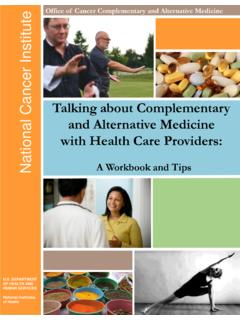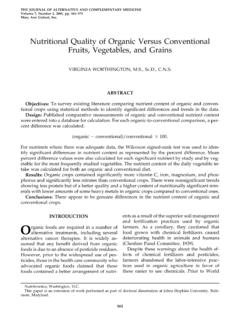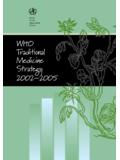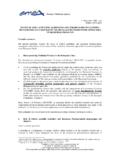Transcription of The regulatory status of Complementary and …
1 The regulatory status ofComplementary and AlternativeMedicinefor medical doctors in Europe!!!The regulatory status of Complementary and Alternative medicine for medical doctors in Europe 2 The CAMDOC Alliance, the alliance of the four major European medical CAM umbrella organisations ECH, ECPM, ICMART and IVAA published this document in January 2010 as a preliminary description of the current regulatory status of CAM in the EU member states. It is based on data provided by their national member organisations.
2 Physicians specialised in one or more CAM modalities integrate these therapies into patient care within the context of general medical practice, conventional specialist practice or may practice CAM full-time. CAM treatment is provided within a care plan that includes conventional medical diagnosis, prognosis and treatments. European Committee for Homeopathy (ECH), Chauss e de Bruxelles 132, box 1, 1190 Brussels, Belgium. e-mail: European Council of Doctors for Plurality in medicine (ECPM), 1 Rue Goethe, 67000 Strasbourg, France.
3 E-mail: International Council of Medical Acupuncture and Related Techniques (ICMART), General Secretary, Rue de l'Amazone 62, 1060 Brussels, Belgium e-mail: International Federation of Anthroposophic Medical Associations (IVAA), Rue du Tr ne 194, 1050 Brussels, Belgium e-mail: The regulatory status of Complementary and Alternative medicine for medical doctors in Europe 3 Summary The most commonly used CAM therapies in Europe that are practised by medical doctors are acupuncture, homeopathy, phytotherapy, anthroposophic medicine , naturopathy, Traditional Chinese medicine , osteopathy and chiropractic.
4 Due to a great variety of medical cultures and traditions in different parts of Europe, CAM looks back on a well-established tradition in some countries or is hardly recognized and available in others. The regulatory status of CAM is complicated by the different models applied in the EU Member States to provide medical services in their respective countries. CAM is primarily provided by physicians in Middle and Southern Europe, whilst the practice of CAM outside of regulated health care is illegal and violations are considered an offence.
5 By contrast, in Northern Europe the practice of CAM by non-medically qualified practitioners is allowed which has led to a situation where treatment providers outside of the established health service constitute the core CAM providers. The extent to which countries have established a statutory regulation of CAM and how such regulation is performed varies widely. Some countries have government-administered regulations or laws about the practice of CAM in general, some regulate specific CAM therapies, while still others have no CAM regulation at all.
6 In 18 of 29 EU and EEA countries specific CAM therapies are statutorily regulated although wide variations exist throughout Europe regarding the types of CAM that are regulated. In some countries some CAM therapies are recognised as specific medical qualifications. In a few countries diplomas for doctors who have taken a full course of a particular CAM modality are issued and recognised by the national medical associations/chambers/councils. However, there is no mutual recognition of diplomas among the various Member States, which impedes the free movement of CAM doctors.
7 Approximately 180,000 medical doctors in the European Union have taken training and education in one or more CAM modalities. Familiarisation courses about CAM therapies are provided in the medical undergraduate curriculum as a part of a course on Complementary and Alternative medicine in several countries. These courses are optional in most countries, obligatory in some. Postgraduate training courses in specific CAM therapies are provided to doctors at several universities in the majority of EU Member States, in other countries at private teaching centres only.
8 Professorial chairs of CAM exist in at least 9 EU Member States, in some Member States also chairs in a specific CAM therapy. The regulatory status of Complementary and Alternative medicine for medical doctors in Europe 4 Introduction Complementary and alternative medicine (CAM) is becoming increasingly popular in Europe with up to 65% of the population reporting that they have used this form of medicine . Approximately 30-50% of the European population use CAM as self-support and 10-20% of the European population has seen a CAM physician/practitioner within the previous year.
9 The most commonly used CAM therapies in Europe that are practised by medical doctors are acupuncture, homeopathy, phytotherapy, anthroposophic medicine , naturopathy, Traditional Chinese medicine , osteopathy and chiropractic. The popularity of the individual therapies, however, differs widely between countries. This diversity is both a challenge for examining the state of CAM in Europe and an opportunity since its inherent plurality gives Europe a unique richness and leading position in the world in terms of the variety of approaches, high quality, integrated, holistic and patient oriented healthcare.
10 The regulatory status of CAM in Europe reflects the diversity of acceptance, use and availability of these treatment approaches in the EU Member States. Due to a great variety of medical cultures and traditions in different parts of Europe, CAM looks back on a well-established tradition in some countries or is hardly recognized and available in others. Models of statutory regulation There are three main models used to regulate the practice of medicine , namely direct government-administered regulation, government-sanctioned self-regulation and independent self-regulation1.






